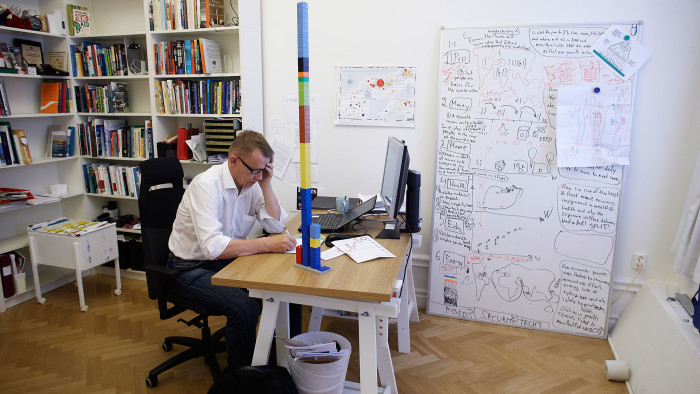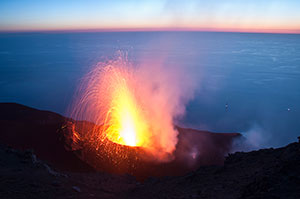Science: Hans Rosling – data rock star

Simply sign up to the Life & Arts myFT Digest -- delivered directly to your inbox.
“I haven’t achieved impact. I’ve got fame but no impact. My son tells me I have the [worst] fame-impact ratio in the world.” It’s a little odd to hear Hans Rosling complain about a lack of influence. Can a man who is invited to speak to world leaders, bosses of some of the biggest companies on the planet and organisations such as the IMF – and who, in 2012, was included in Time magazine’s 100 most influential people in the world – really feel insignificant?
Rosling insists that these are not his target audience. The people he is aiming at – the general public of developed nations – are, for the most part, blissfully ignorant of his data-driven message. “The world is discussed in terms of feelings and ideologies rather than as an area of knowledge,” he says.
Ever since his hugely popular TED talk in 2006, “The Best Stats You’ve Ever Seen”, an early example of the power of data visualisation to explain complicated numbers, Rosling has been described as the king of data, the closest thing statisticians have to a rock star. After training as a medical doctor and a statistician in his native Sweden, Rosling worked in Mozambique in the 1970s and spent the next two decades studying disease and nutrition in Africa. He first got into data storytelling and visualisation when teaching in the 1990s.
In 2005, he set up the Gapminder Foundation with the aim of developing software called Trendalyzer, which could convert sets of data into eye-catching animated graphics. Alongside this, Rosling has drawn increasingly large audiences to his humorous and engaging public talks.
The message Rosling wishes to convey is an end to the old “them and us” mentality. This is the inspiration behind perhaps his most famous chart – a comparison of different countries’ life expectancy and their citizens’ average income. The key point is to show how quickly many developing nations have moved into the middle-income, high-life-expectancy bracket in recent years. “You cannot divide the countries of the world into two groups: we and them. That is a very peculiar world view. Is Turkey we or them? Is Mexico we or them? Where do you draw the line?”

But public perception has not kept up with the pace of economic and demographic development across large swaths of the world. Rosling wants us to recognise that these are no longer poor countries.
Understanding the state of the world is vital to how people make daily choices, he insists. “It will impact on their decisions about where they place their pension funds, where they go on holiday, where they would like aid money to be spent, how they judge trade policy should be in their country and how they vote for that – that’s the ignorance we have to fight, because it’s devastating.”
Despite the panoply of information available from the IMF, OECD and World Bank, few media outlets have found attractive ways of displaying it. “The data people talk with the analysts and then they send it off to a designer and the designer makes a contract with a coder and then it comes back and it’s never nice,” he says. “You have to do the data, the analysis, the design and the coding all together.”
Trendalyzer was so successful at displaying data that, in 2007, Google acquired the software along with its development team, which included Rosling’s son and daughter-in-law. It now forms the engine behind the live charts in Google’s search function.
The money from the sale went to consolidate the foundation, enabling Rosling to quit his day job as an academic and embark full time on his assault on public ignorance. (He still retains a role as professor of public health science at the Karolinska Institute, which awards one of the Nobel Prizes.) Having bedded Trendalyzer into Google, his family moved back to Sweden to join him.
The lucrative deal allowed Rosling to run Gapminder as a not-for-profit organisation. The foundation also receives funding from donations, grants and lecture fees. “Some functions are better outside the market economy, like museums,” he says.
Rosling says this “privileged” financial position allows him to try out new ideas, practise them and field-test them on audiences. It also enables him to avoid being dragged into advocacy work. “We are not for or against nuclear power, we are not for or against carbon capture, we are not for or against this or that. We do not say that HIV is a bigger problem than female illiteracy. We show how much HIV there is, and how much female illiteracy there is.” Given the facts, it is then the audience’s responsibility to reach its own conclusions.
Having grabbed international attention with his talks, Rosling has shifted Gapminder’s focus to developing teaching materials for schools, hoping that the knowledge imparted to children will percolate upwards to their parents’ generation as well. Capturing and holding children’s attention is a challenge – far more so than lecturing and making videos targeted at adults. “Media is voluntary; education is compulsory,” he laughs. He is also increasingly moving into what he endearingly calls “show business”. Last November, the BBC broadcast Don’t Panic – The Truth About Population , his one-hour programme challenging the dread with which many view population growth. He dubs his role as an “edutrainer” but this brings with it a fresh set of tensions. “You have to be like the worst tabloid newspaper in the front and the Academy of Science in the back.”
A spray of hope

China’s severe urban air pollution could be reduced by spraying water from sprinklers on top of tall buildings, according to a study conducted at Zhejiang University
This tension between populism and science is the golden thread that runs through Rosling’s work, and informs his approach to the most contentious of political debates – such as fears over global resources as developing nations’ consumption soars. “People think, ‘They cannot live like us, that would never work,’” he sighs. “People [in countries with high carbon emissions] say, ‘If you live like us, you will destroy the planet.’” Rosling openly deplores this approach. Instead of opposing poorer countries’ right to develop industrially, and thus emit more carbon, he suggests richer states should focus on seeking scientific solutions to problems such as carbon emission.
This is the heart of Rosling’s attempt to gain not just fame but influence: eye-catching data-rich graphics presented with an impish sense of humour and an eye for contrarian conclusions. The population boom? Not going to happen.
Global warming? Not too worrying. Poverty? Yesterday’s problem. He believes the world is in much better shape than many people in the developed world fear. But, more importantly, whatever one’s view about the future of the planet, Rosling aspires to make sure it is based on data, not on sentiment.
——————————————-
The magma charter: supervolcano strategy
The eruption of a “supervolcano” is the biggest natural threat to human civilisation, apart from a large asteroid hitting Earth, writes Clive Cookson. Every hundred thousand years, a super-eruption spews enough ash and lava, dust and gas into the atmosphere to lay waste to thousands of square kilometres of land and plunge the climate into a long volcanic winter. The most recent example, which took place 70,000 years ago at Mount Toba in Indonesia, induced a decade-long chill that almost wiped out human life outside Africa.
The mechanism of super-eruptions is fundamentally different from normal volcanic activity observed in historic times, as two studies published this month in the journal Nature Geoscience show. One used the European Synchrotron Radiation Facility in France to recreate the conditions inside the magma chamber of a supervolcano. The other study simulated super-eruptions through computer modelling.

In an ordinary volcano, molten rock (magma) accumulates from below in an underground chamber until sufficient pressure builds up for it to break out. A super-eruption, in contrast, starts when a far larger volume of magma accumulates beneath the surface. Then, as the research shows, the sheer buoyancy of the magma, which is less dense than the rock strata on top of it, bursts open the Earth and lets out lava, ash and gas on a cataclysmic scale.
One analogy for the buoyancy effect is someone trying to hold down a big ball as it is inflated under water. Eventually it becomes impossible to stop it shooting up through the water and into the air. An ordinary eruption is more like blowing up a small balloon until the pressure inside bursts it.
Some volcanoes alternate between relatively frequent small eruptions, when the magma generates enough pressure for a limited local breakthrough, and rare super-eruptions when the whole magma chamber becomes buoyant.
An example in the Chilean Andes is the caldera of Laguna del Maule, 20km in diameter, which was the scene of super-eruptions 1.5 million, 950,000 and 340,000 years ago. Over the past 25,000 years, Laguna del Maule has also experienced 36 smaller eruptions, each creating its own lava dome.
Volcanologists do not believe that a super-eruption is likely anywhere in the world in the near future but the latest studies will help them devise better tools for monitoring rock deformation and magma pressure and buoyancy in possible trouble spots such as Yellowstone National Park in the US – just in case.
Comments